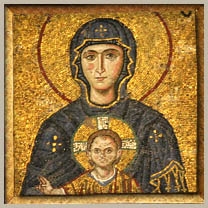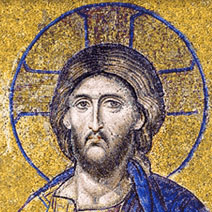These amazing drawings prove that the mosaics of Hagia Sophia were uncovered for almost 300 years after the conquest. Millions of Muslim worshippers prayed under Christ, the Virgin and the Seraphim.

 The Imperial Children In, the course of many centuries, a tenacious struggle, being carried on between Russia and Sweden, the lands on both sides of the Neva greatly suffered from ravage and plunder, which inevitably accompanied war in those times. The population was ruined not only by compulsory service in the army, but also by constant military quarterings, forcible requisition, and absence of discipline in the troops of both adversaries. The enemy came, burnt plundered and led into captivity; the Russians likewise plundered, and made captives, killing seldom. Nevertheless, however painful the position of the population was, the fear of the, Swedish sovereignty, the consciousness of belonging to the Russian Novgorodian land, and the devotion to the Orthodox religion, were so strong, that when, by the Peace of Stolbovo and Kardissa, the right was given to all, who wished, to retire within the term of two weeks from the lands, given over, to Sweden an enormous majority of the population abandoned its fields, huts and estates, in order to go and settle elsewhere. In consequence Gustavus Adolphus was obliged to undertake a whole series of administrative measures for the colonization of the country, conquered by such a struggle. Royal privileges attracted not only impoverished Swedish noblemen but also Germans, persecuted in their native country for professing Lutheranism, and many peasants from Swedish Finland.After the Peace of Kardissa, the province of Orehovetz, until the 17th century most thickly populated, became quite deserted. The successors of Gustavus Adolphus actively attended to the colonization of the newly acquired lands. Everything, that was Russian, was being carefully exterminated. The ancient Novgorodian land Vod, was called Ingermanland; the town Korela was named Keksholm, Orehovetz-Neteborg. Particular privileges were given not only to these towns and to the new Nien, but even to the cities, which, existed only in the minds of the Swedish statesmen. The lands were given in fief to the newly settled noblemen; the peasants, who remained in the country, were forced to settle on the new ground, in order to enlarge by their labor the area of cultivated land; important privileges were granted to trade - the Orthodox inhabitants were converted by force to Lutheranism, and, in order to spread Swedish ideas by means of the press, a Russian printing-office was established in Stockholm. All Swedish efforts could not compel the population to forget, that it was Russian; on every favorable occasion in the country the people rose in revolt; emigration did not cease and, during the eighty years of the Swedish possession, the country became more desolate, than it had been, during the three centuries of almost uninterrupted wars, which took place before the "smoutnoe vremia" (days of trouble). Peter the Great found the country deserted; in the place of villages, uncultivated ground. Many villages still kept old Russian names, but were peopled by Finns and German colonists. Orthodoxy was perishing; old people still clung firmly to the true faith, but the young Russians, as well as Finns, professed Lutheranism. The Swedish government, laying a restraint on the rights of the Orthodox natives, gave immense privileges to those, who changed their religion. The Swedes did not allow the Russian bishops to ordain priests, and their number was gradually diminishing. The Russian noblemen, who remained in Ingermanland, gradually went over to Lutheranism, for fear of losing the right to possess estates. Towards the end of the 17th century, in the families Aminov, Boutourline, Peresvetov and Nassakin, only the old women remained Orthodox. The populace, nevertheless, held strongly to the religion of their ancestors and, though suffering from the persecution of the Swedes, !still dreamt of better times, preferring to have no priests at all, or to abandon their piece of ground and flee to Russia, rather than go over to the Lutheran church. The country was divided by the Swedish administration into Ingermanland and Karelia. At the head of each province stood the king's Lord-Lieutenant landsgevting. One of them lived in Narva, the other in Keksholm. The Kronfogts, who stood at the head of districts, and the burgomasters in the towns were submitted to them. The chief command over all the country was entrusted to the governor-general of Lifland, Ingermanland and Karelia. Outside the towns, the territories, according to the old Russian custom, were divided into districts and parishes. The gathering of the tributes was also done by the Novgorodian "obya", the land measure. The Landsgevtings possessed not only the administrative power and the right of superintendence of the tribunal, but were also the tenants of the province, paying out personally to the crown all the revenue, received from the population. This arrangement led, of course, to great abuse, especially as the landsgevtings had also the inspection of the church. Since the Swedes had taken possession of the country, all the lands and the whole taxed class, being the personal possession of the crown, which disposed of both the property and labor of the peasants, the newly-settled feudal proprietors were in great need of workmen. It seems, that the German colonists soon abandoned the country, settled in the towns, and began their commercial speculations. Had it not been for the great commercial importance of the town Nien, founded in 1611, on the place of Okta, the lands on the banks of the Neva, Slavyanka, and Ijora would have become completely deserted, under the intolerable yoke of the Swedish power and the feudal system, introduced there. The Swedes, with their politics, contrived to devastate the conquered province to such a degree, that Peter was obliged to begin repeopling it, as if it had been hitherto a desert.
|









